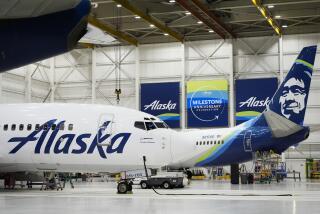Assurances on Air Safety Needed
Alaska Airlines Flight 261 went down off the Ventura County coast nearly two months ago, killing all 88 passengers and crew aboard. Since that time, the federal investigation into the cause of the crash has focused on the MD-80 aircraft’s tail stabilizer system and, more specifically, on a jackscrew or bolt. Was it properly maintained?
The answer still eludes investigators, but the trail seems to lead back to a long-standing question for the airline industry, the Federal Aviation Administration and the National Transportation Safety Board: Do they really have a handle on the quality of aircraft maintenance conducted across the nation?
Systemic problems in aircraft maintenance and storage of dangerous cargo were supposed to have been addressed after the 1996 ValuJet crash in the Florida Everglades that killed all 110 aboard. More than 1,000 more FAA inspectors were to be hired, raising the total to more than 3,700, and strict new procedures were required. Is it working?
Federal prosecutors had already launched a grand jury probe into Alaska Airlines’ maintenance hangar in Oakland when Flight 261 crashed. The investigation was based on allegations that mechanics there falsified safety records and allowed two planes to fly in unairworthy condition. Alaska Airlines denies that. It says it’s cooperating with the FAA and has hired its own outside experts as well.
After ValuJet, the FAA adopted new inspection procedures for the nation’s 145 airlines and 3,000 repair stations, establishing regular procedures for investigations at the local, regional and national levels. Among the changes: better surveillance and trouble-shooting, particularly with start-ups and rapidly growing airlines. It’s a sound concept, but problems remain. The 10 largest airlines, accounting for the bulk of air traffic, have signed on, but a considerable number of other fleets have yet to get aboard. Meanwhile, FAA administrators admit privately to the system’s most vulnerable spot, the huge number of aircraft repair stations.
FAA penalties remain paltry. Consider the meager $90,000 fine that the agency levied this month against a major airline for permitting a plane to fly with an improperly installed wheel bearing on its landing gear. The aircraft, a Boeing 737-300, flew 46 round trips before the left main inner gear and tire assembly fell off during a takeoff. Fortunately, the aircraft landed safely and no one was injured.
The Alaska Airlines crash has returned the flying public’s focus to how well the nation’s air fleet is maintained. It deserves more assurances that the FAA has the matter in hand.
More to Read
Sign up for Essential California
The most important California stories and recommendations in your inbox every morning.
You may occasionally receive promotional content from the Los Angeles Times.










